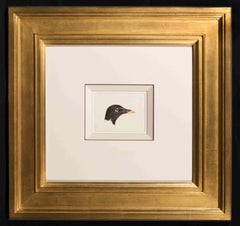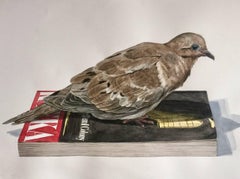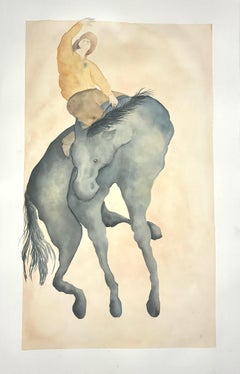Joseph Mallord William Turner Paintings
to
1
Overall Width
to
Overall Height
to
1
1
1
1
1
1
1
2
784
716
703
698
1
Artist: Joseph Mallord William Turner
Study of the Head of a Moorhen
By Joseph Mallord William Turner
Located in Belgravia, London, London
Watercolour on paper
Paper size: 4 x 5 inches
Framed size: 19 x 19.75 inches
PROVENANCE
A gift from Joseph Mallord William Turner to Miss Amelia Hawksworth (later Mrs Hotham), niece of Walter Fawkes. The watercolour descended through the ownership of Amelia Hawksworth, daughter of Francis Fawkes ( Walter Fawkes's brother) who was the main compiler of the Ornithological Collection (Miss Hawksworth owned five other bird studies by Turner).
Private collection, London
LITERATURE:
For similar works by J M W Turner see Anne Lyles, The Tate catalogue for the exhibition 'Turner and Natural History, The Farnley Project', 1988.
The present watercolour was drawn circa 1815-1820 for Walter Fawkes of Farnley Hall, for his Ornithological Collection Volume IV.
Between 1808 and 1824, Turner visited Farnley Hall in Yorkshire to stay with the Fawkes family. Turner felt at home at Farnley - the Fawkes daughters reminded him of his own. He helped illustrate a five volume ornithological scrap book for the Fawkes children, making watercolour studies of the birds for the children to stick in opposite the pages on which feathers from similar birds were attached. His bird portraits were most effective, most "life-like", when in fact the bird was dead ! His watercolours of a live robin and goldfinch have a more hesitant touch.
At this time Turner enjoyed the patronage first of Edward Lascelles, the heir to Harewood, and after 1808, of the radical landlord Walter Fawkes of Farnley Hall, near Otley. He became a close friend of the Fawkes family with whom he stayed for most summers until 1824.
The last owner of Old Farnley Hall was Francis Fawkes, a rich widower with no direct heirs. When Francis Fawkes died in 1786 he left the house to Walter Beaumont Hawksworth of Hawksworth Hall, on condition that Hawksworth adopt the Fawkes name by Royal Licence. Walter Fawkes brought in architect John Carr of York to make extensions to the house, but he died before the work was completed, and Farnley Hall was passed on to his son, also called Walter who also took the Fawkes name and was known as Walter Ramsden Fawkes. It was this Walter who was a great friend of J M W Turner.
Anne Lyles has confirmed the attribution and writes:
"Everything fits in relation to the style of the watercolour and most especially the provenance - in the Turner and Natural History exhibition catalogue of 1988 we know that Amelia Hawksworth (Mrs Hotham) owned three studies of birds' heads by J M W Turner (previously with the Maas Gallery, and numbers 36, 37 and 61 in that catalogue) as well as two studies of dead game by the artist (catalogue numbers 59 and 63, the latter untraced in 1988). Interestingly, catalogue numbers 36 and 37 (the Merganser and the Smew) seem also originally to have been intended for Volume IV of the Ornithological Collection - it is likely that the "Study of the Head of a Moorhen...
Category
19th Century Joseph Mallord William Turner Paintings
Materials
Paper, Watercolor
Related Items
The Reader
By Thomas Broadbent
Located in New York, NY
Signed on reverse, 22"x30" available unframed.
Thomas Broadbent has shown extensively throughout the U.S. as well as internationally. Broadbent’s work won the Pulse Prize for best s...
Category
2010s Contemporary Joseph Mallord William Turner Paintings
Materials
Watercolor, Archival Paper
To Be Listened To
Located in Bozeman, MT
Jess Kellner is a multi disciplinary artist who’s work has a strong focus on exploring the human condition. It’s a theme that you see in his artwork as well as his filmmaking. While ...
Category
2010s Contemporary Joseph Mallord William Turner Paintings
Materials
Paper, Watercolor
Red Seascape, Abstract Geometric Fish Patterns, Monoprinting on Rag Paper, 2024
Located in Barcelona, ES
This series by Enric Servera explores the relationship of humans to salt and seawater. The intention of these works is to submerge us into the sea, a salty treasure that surrounds us...
Category
2010s Abstract Joseph Mallord William Turner Paintings
Materials
Acrylic, Watercolor, Rag Paper, Monoprint
"In My Shoes" Watercolor on Paper (contemporary surrealist painting, ibis bird)
By Thomas Broadbent
Located in New York, NY
30"x22" watercolor on paper, signed on reverse. New York artist, Thomas Broadbent, well know for his contemporary naturalist depictions of the intersection of nature and man, presents a humorous depiction of an ibis bird...
Category
2010s Contemporary Joseph Mallord William Turner Paintings
Materials
Watercolor, Archival Paper
Seascape, Abstract Geometric Fish Patterns, Orange Monoprinting on Paper
Located in Barcelona, ES
This series by Enric Servera explores the relationship of humans to salt and seawater. The intention of these works is to submerge us into the sea, a salty treasure that surrounds us...
Category
2010s Abstract Joseph Mallord William Turner Paintings
Materials
Acrylic, Watercolor, Rag Paper, Monoprint
"Refugees" contemporary surrealist painting moose, wolverine, beaver on sailboat
By Thomas Broadbent
Located in New York, NY
40"x60" large scale watercolor on paper, featuring a moose, beaver, wolverine, cardinal and raven on a distressed sailboat, whose sail is mended with colorful blue checkered and red polka dot quilted fabric. A telescope stands...
Category
2010s Contemporary Joseph Mallord William Turner Paintings
Materials
Watercolor, Archival Paper
"Blue Goblet" (white lamb) Contemporary Surrealist Painting Animal Still Life
By Thomas Broadbent
Located in New York, NY
40"x60" watercolor on paper, signed on reverse by the artist, Thomas Broadbent.
This painting depicts a lone lamb standing with a natural fiber rope lead loosely coiled around one leg. A blue crystal goblet is set in front of the white, fluffy sheep...
Category
2010s Contemporary Joseph Mallord William Turner Paintings
Materials
Watercolor, Archival Paper
To Say I Love You, Even As We Fall
Located in Bozeman, MT
Jess Kellner is a multi disciplinary artist who’s work has a strong focus on exploring the human condition. It’s a theme that you see in his artwork as well as his filmmaking. While ...
Category
2010s Contemporary Joseph Mallord William Turner Paintings
Materials
Paper, Watercolor
"Shore House" watercolor on paper, 30"x22", signed on reverse
By Thomas Broadbent
Located in New York, NY
30"x22 watercolor on paper, signed on the reverse by the artist.
This watercolor painting by Thomas Broadbent is composed of stacked books to create a "birdhouse" from an architecture of printed matter and rubber bands. The title "Shore House...
Category
2010s Contemporary Joseph Mallord William Turner Paintings
Materials
Watercolor, Archival Paper
$3,400
H 33 in W 22 in
Photo Finish - Horses Racing, Horse Racing Art, Animal Art, Sports Painting
By Garth Bayley
Located in Deddington, GB
Photo Finish -Horses Racing an original painting by Garth Bayley. Pen and ink Capturing the moment the horses fly past the posts Affordable art.
Discover works by Garth Bayley online...
Category
2010s Expressionist Joseph Mallord William Turner Paintings
Materials
Paper, Watercolor
$241
H 9.45 in W 12.6 in D 0.04 in
Moonlit
By Kat Kinnick
Located in Bozeman, MT
Illustrating wildlife and the wilderness of the High Desert of New Mexico, Kat Kinnick works to inspire a culture of connectedness to nature. She's inspired by the magic and inexplic...
Category
2010s Contemporary Joseph Mallord William Turner Paintings
Materials
Paper, Gouache
A Complimentary Pair
By Kat Kinnick
Located in Bozeman, MT
Paying attention to what's outside, beyond walls, fences and myths of the modern world, my painting process inspires me to become more aware, attuned and present. I get excited notic...
Category
2010s Contemporary Joseph Mallord William Turner Paintings
Materials
Paint, Paper, Gouache
Joseph Mallord William Turner paintings for sale on 1stDibs.
Find a wide variety of authentic Joseph Mallord William Turner paintings available for sale on 1stDibs. You can also browse by medium to find art by Joseph Mallord William Turner in paint, paper, watercolor and more. Not every interior allows for large Joseph Mallord William Turner paintings, so small editions measuring 20 inches across are available. Joseph Mallord William Turner paintings prices can differ depending upon medium, time period and other attributes. On 1stDibs, the price for these items starts at $179,627 and tops out at $179,627, while the average work can sell for $179,627.


